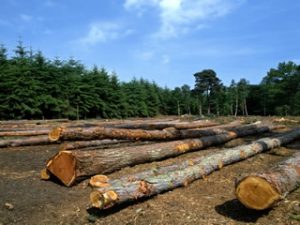Carolina “Clean” Coal
Is wood the new coal? Researchers at North Carolina State University think so, and they are part of a team working to turn woodchips into a substitute for coal by using a process called torrefaction that is greener, cleaner and more efficient than traditional coal burning.
Environmental organizations have raised concerns for decades about the environmental impact of the burning of fossil fuels – particularly coal – for energy. The combustion of coal contributes to acid rain and air pollution, and has been connected with global warming.
During torrefaction, woodchips go through a machine – almost like an industrial-sized oven – to remove the moisture and toast the biomass. The machine, called a torrefier, changes more than just the appearance of the woody biomass. The chips become physically and chemically altered – through heat in a low-oxygen environment- to make them drier and easier to crush.
The torrefied wood is lighter than the original woodchips but retains 80 percent of the original energy content in one-third the weight. That makes them an ideal feedstock for electric power plants that traditionally use coal to generate energy for businesses and residential neighborhoods.
While the process of torrefaction is nothing new, NC State’s particular torrefier machine, called the Autothermic Transportable Torrefaction Machine (ATTM), is field portable and self-heated. Traditional torrefier machines are bulky and immobile, but the ATTM lends itself to field-based operations, which reduces the cost of transporting tons of woody biomass to and from the combustion facilities. The ATTM is also largely self-powered, producing a large energy return while also removing carbon from the atmosphere.
“This process could help us build a bridge to more energy independence,” says Chris Hopkins, a doctoral student in forestry at NC State and developer of the torrefier machine.
Woodchips are abundant in North Carolina while coal is all imported from other states. More importantly, woodchips are a carbon neutral source of energy. For a state that spends more than $4 billion a year importing coal, use of torrefied wood could result in an economic windfall.
Hopkins explains that nearly half of the state’s forests are not adequately thinned because landowners lack a market for small diameter trees, rotten or unusable trees and logging residue. That land could be producing more valuable wood products if it was managed more effectively, he says.
If woodchips were collected and sold to help fire North Carolina’s energy generating plants, the state’s tax base could be increased by nearly $400 million a year, Hopkins estimates. Since the torrefier machine is small enough to transport, it could be set up close to forest-clearing operations, making the process even more efficient.
NC State’s Office of Technology Transfer (OTT) announced an exclusive license agreement with AgriTech Producers, LLC of Columbia, S.C. to commercialize this technology, called “Carolina Coal.” Billy B. Houghteling, director of OTT, says, “This partnership is an example of how NC State contributes to the strengthening of our state and national economy. By partnering with organizations like AgriTech, the university’s scientific discoveries move beyond the Belltower and into the marketplace where they can really make a difference.”
- Categories:
